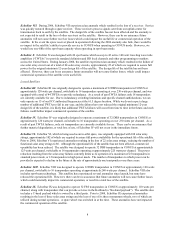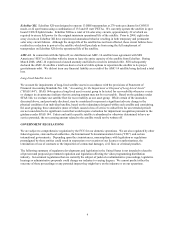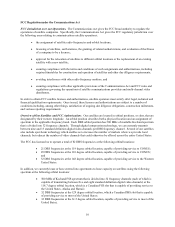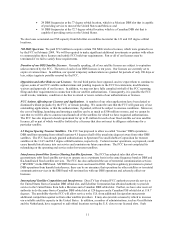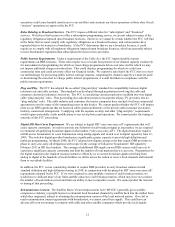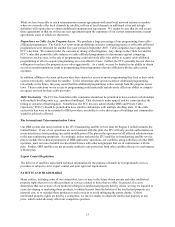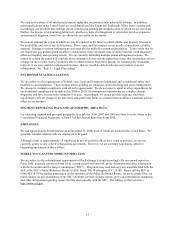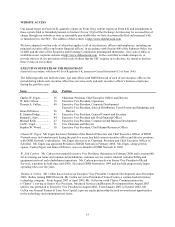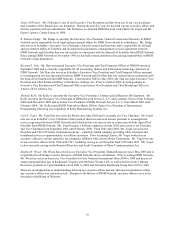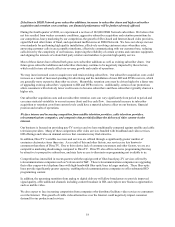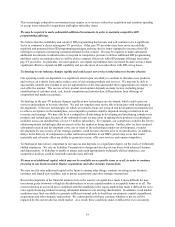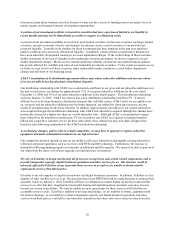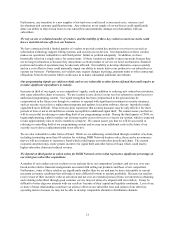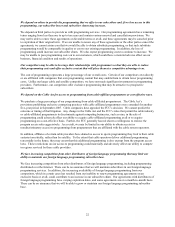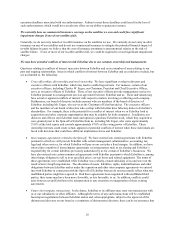Dish Network 2008 Annual Report Download - page 28
Download and view the complete annual report
Please find page 28 of the 2008 Dish Network annual report below. You can navigate through the pages in the report by either clicking on the pages listed below, or by using the keyword search tool below to find specific information within the annual report.18
If declines in DISH Network gross subscriber additions, increases in subscriber churn and higher subscriber
acquisition and retention costs continue, our financial performance will be further adversely affected.
During the fourth quarter of 2008, we experienced a net loss of 102,000 DISH Network subscribers. We believe this
net loss resulted from weaker economic conditions, aggressive subscriber acquisition and retention promotions by
our competition, heavy marketing by our competition, the growth of fiber-based and Internet-based video providers,
signal theft and other forms of fraud, and operational inefficiencies at DISH Network. We have not always met our
own standards for performing high quality installations, effectively resolving customer issues when they arise,
answering customer calls in an acceptable timeframe, effectively communicating with our customer base, reducing
calls driven by the complexity of our business, improving the reliability of certain systems and customer equipment,
and aligning the interests of certain third party retailers and installers to provide high quality service.
Most of these factors have affected both gross new subscriber additions as well as existing subscriber churn. Our
future gross subscriber additions and subscriber churn may continue to be negatively impacted by these factors,
which could in turn adversely affect our revenue growth and results of operations.
We may incur increased costs to acquire new and retain existing subscribers. Our subscriber acquisition costs could
increase as a result of increased spending for advertising and the installation of more HD and DVR receivers, which
are generally more expensive than other receivers. Meanwhile, retention costs may be driven higher by a faster rate
of upgrading existing subscribers’ equipment to HD and DVR receivers. Additionally, certain of our promotions
allow consumers with relatively lower credit scores to become subscribers and these subscribers typically churn at a
higher rate.
Our subscriber acquisition costs and our subscriber retention costs can vary significantly from period to period and
can cause material variability to our net income (loss) and free cash flow. Any material increase in subscriber
acquisition or retention costs from current levels could have a material adverse effect on our business, financial
position and results of operations.
We face intense and increasing competition from satellite television providers, cable television providers,
telecommunications companies, and companies that provide/facilitate the delivery of video content via the
internet.
Our business is focused on providing pay-TV services and we have traditionally competed against satellite and cable
television providers. Many of these competitors offer video services bundled with broadband and video services,
HD offerings and video on demand services that consumers may find attractive.
In addition, DirecTV’s satellite receivers and services are offered through a significantly greater number of
consumer electronics stores than ours. As a result of this and other factors, our services are less known to
consumers than those of DirecTV. Due to this relative lack of consumer awareness and other factors, we are at a
competitive marketing disadvantage compared to DirecTV. DirecTV also offers exclusive programming that may
be attractive to prospective subscribers, and may have access to discounts on programming not available to us.
Competition has intensified in recent quarters with the rapid growth of fiber-based pay-TV services offered by
telecommunications companies such as Verizon and AT&T. These telecommunications companies are upgrading
their older copper wire telephone lines with high-bandwidth fiber optic lines in larger markets. These fiber optic
lines provide significantly greater capacity, enabling the telecommunications companies to offer substantial HD
programming content.
In addition, the upcoming transition from analog to digital delivery will allow broadcasters to provide improved
signal quality, offer additional channels including content broadcast in HD, and explore new business opportunities
such as mobile video.
We also expect to face increasing competition from companies who distribute/facilitate video services to consumers
over the Internet. This growth of viable video alternatives over the Internet could negatively impact consumer
demand for our products and services.


